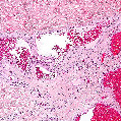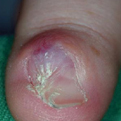Glomus Tumors
General Information
Glomus Tumors are relatively uncommon benign neoplasms that differentiate to become modified smooth muscle cells called glomus cells. There are two different types of glomus tumors: Solitary and Multiple glomus tumors, which are also known as glomangiomas or glomulovenous malformations. Each of them has distinct clinical and histopathologic characteristics. Glomus tumors are neoplasms caused by a proliferation of glomus cells, which make up a portion of the glomus body. The most common location for these tumors is the distal extremities, especially in subungual areas. The treatment of choice for solitary glomus tumors is surgical excision. For multiple glomus tumors, excision may be more difficult because of their poor circumscription and the large number of lesions. Other reported treatments include argon and carbon dioxide laser therapy and sclerotherapy with hypertonic saline or sodium tetradecyl sulfate.
Epidemiology
Uncommon
Etiology
May arise from perivascular cells that can differentiate into glomus cells
Pathogenesis
Encapsulated, slowly growing, highly vascular, and locally invasive tumors
Clinical
Solitary lesions have a physical appearance of Blue or purple; Papules or nodules that can be blanched. Multiple lesions are blue-to-purple partially compressible papules or nodules that are grouped
Histology
Solitary lesions contain endothelium-lined vascular spaces surrounded by clusters of glomus cells; Multiple lesions contain multiple irregular, dilated, endothelium-lined vascular channels that contain red blood cells.
Bibliography
1. “Glomus Tumor” (Online) March 2007. http://www.emedicine.com/derm/topic167.htm (visited: March 18, 2008) 2. “Glomus Tumor” (Online) December 2006. http://www.emedicine.com/MED/topic2994.htmhtm (visited: March 18, 2008)
Download PDF
![]() Glomus Tumors
Glomus Tumors


